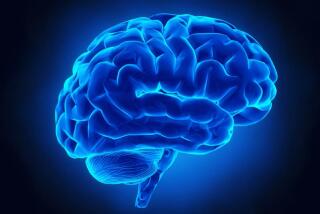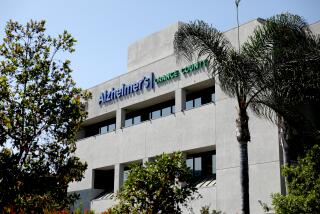Brain Bank May Hold Answer to Alzheimer’s : Medicine: The 1,400 specimens are frozen and are used by researchers in their study of the disease and other neurological and psychiatric disorders.
- Share via
ST. PAUL, Minn. — William H. Frey II’s job is picking people’s brains.
Literally.
A biochemist and keeper of the Ramsey Foundation’s Brain Bank, Frey uses his collection to conduct research on the human brain in relation to Alzheimer’s disease and other neurological and psychiatric disorders.
Begun in 1978, the bank’s “deposits” have grown to about 1,400 specimens and include the brains of Frey’s maternal grandmother and two of her siblings. The St. Paul bank and the 1,800-specimen National Alzheimer’s Disease Brain Bank in La Jolla, Calif., are among the nation’s largest collections of brains for research on Alzheimer’s disease, the fourth-leading cause of death in the United States.
Frey, 43, received $100,000 from the Legislature in the late 1980s to study 200 medical assistance recipients diagnosed with dementia-causing illnesses and then conduct autopsies after they die to study the effectiveness of treatment. He expects to complete the study in about five years.
Having brain-bank researchers evaluate patients before they die is critical to Alzheimer’s research, said Creighton Phelps, senior vice president for medical and scientific affairs of the National Alzheimer’s Assn. in Chicago.
The Joseph and Kathleen Bryan Alzheimer’s Disease Research Center at Duke University Medical Center in Durham, N.C., has collected more than 50 brains after evaluating the patients when they were alive. The center freezes the brains in liquid nitrogen within an hour of death.
“Logistically, it’s tough to do elsewhere,” said Mark Alberts, a Duke neurology professor.
The Minnesota brain bank consists of several freezers at St. Paul-Ramsey Medical Center, which hold about 700 specimens sectioned into about 10 pieces each in plastic bags. The others have been used up in medical research here and around the country.
A local user of the brain bank is the new Brain Sciences Center, a joint federal, state and private medical venture to study the human brain at the Minneapolis Veterans Administration Medical Center.
Frey receives brains from a nationwide network of about 250 pathologists aware of his work as research director for the St. Paul-Ramsey Alzheimer’s Treatment and Research Center, which has a $350,000 budget this year.
He also receives about 130 brains a year of suspected victims of the disease from relatives longing to resolve the mystery and worried about others in their family with similar symptoms. There is no way to be absolutely certain a patient has Alzheimer’s while alive.
Survivors’ hereditary concerns could be well-founded.
A team of researchers at St. Paul-Ramsey Medical Center and the University of Minnesota reported in April a new connection between heredity and Alzheimer’s and ruled out other factors in causing Alzheimer’s: head injuries, drug and alcohol abuse, heart disease, stroke and psychiatric disease.
Still, they said heredity isn’t the sole explanation.
Frey speculates that an “inhaled toxin” could trigger Alzheimer’s in patients with an inherited predisposition to it, but medical center neurologist Mario Mendez has questioned that theory. Mendez notes that Alzheimer’s patients have extensive degeneration in other parts of the brain. He speculates that an infection or some other unknown trigger attacks brain cells needed for thinking, memory and reasoning.
Overall, Frey said, “We are finding that about 23% of the people who are told they have Alzheimer’s actually do not have Alzheimer’s at all, but have some other disease. So this is a major problem in diagnosis.”
Parkinson’s disease, multiple sclerosis, small strokes and brain tumors are often misdiagnosed as Alzheimer’s. It has accounted for about 65% of all cases of dementia that Frey has seen.






